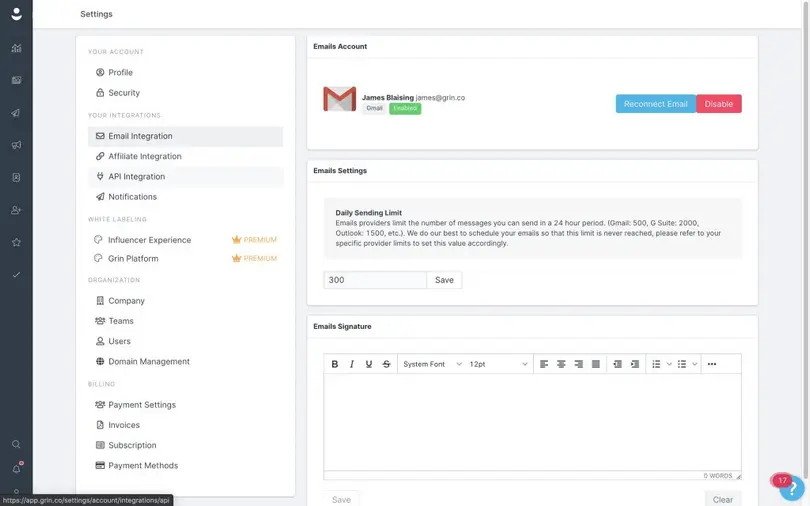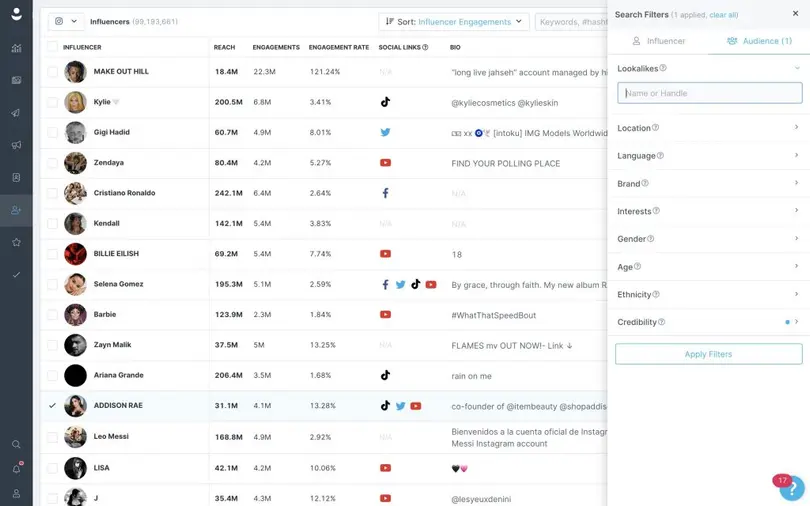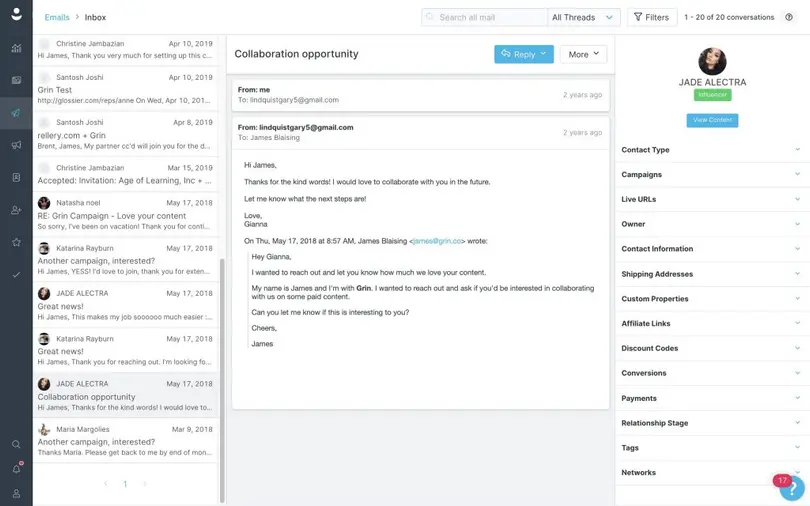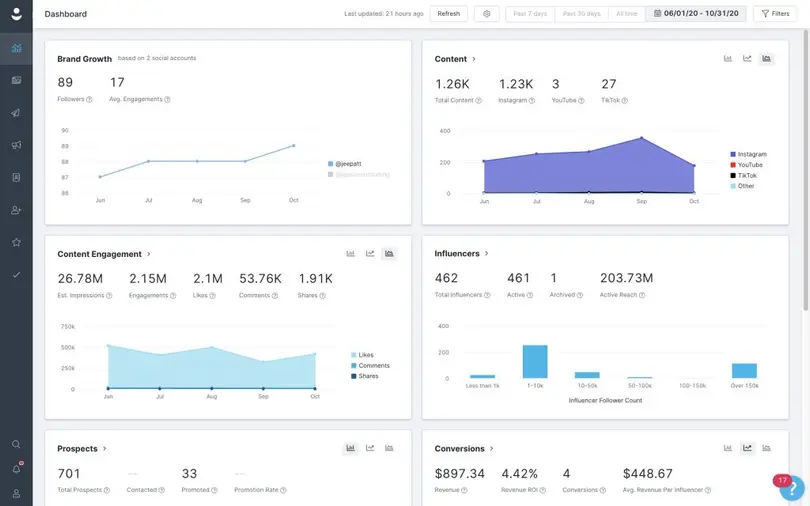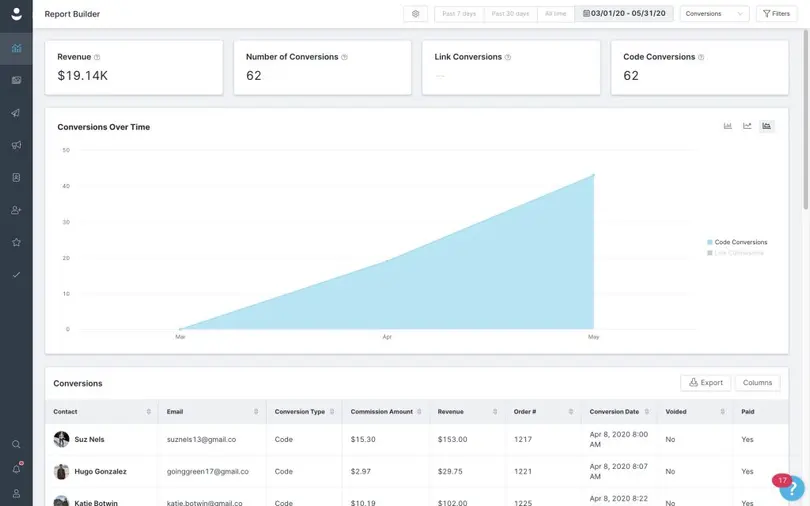
For every SaaS influencer marketplace that’s matching influencers with brands via algorithm, there’s a critic out there decrying their use. It’s inauthentic, they’ll say, and point to relationship-centric platforms like Grin as a model of how to do things right. We’re not here to say that marketplaces are bad, or that they’re ineffective, because there are many we’ve reviewed that are just plain great products. However, we are here to say that Grin is a model of how to do things right.
Influencer marketing became ubiquitous not because it was a cheaper alternative to celebrity endorsements, or because it’s just a more effective way to target advertising to specific audiences. You can do those things, of course, but that’s not the reason influencers have value. Their value is in the authenticity of their endorsements. Influencers become influential because they’ve cultivated a trusting relationship with their audience, not because that audience is big. The idea behind Grin is to capitalize on that influence, but not in a transactional way. The Grin philosophy is that influencer marketing is marketing to the influencer. Build a trusting relationship with them, and all else falls into place.
Perhaps the Grin philosophy is a function of the company’s age: they’ve been around since 2014, a few years before influencer marketing was a thing anyone outside of marketing was talking about. Or maybe it’s because the company’s founders—Brian Mechem and Brandon Brown—both came from the marketing world. Perusing through the Grin website, there’s a love of craft on display that’s impossible to deny. Marketing is something these two take very seriously, even when they’re making a purely technological play at it. And not just their own technology: Grin’s focus is on eCommerce businesses with integrations into some of the major shopping platforms. For all the coding and technical wizardry that goes into Grin, the website reads like a manual for couples therapy, with its focus on things like “relationships,” and “trust,” and “authenticity.”
Kidding aside, this is what makes Grin a standout in its field. Marketplaces are transactional, and while there’s nothing inherently wrong with that it also means the best you can hope for from a platform like that is a mechanism for smooth and beneficial transactions. More direct competitors with Grin may focus their efforts in the same direction, but many of those platforms can have an opportunistic feel to them—as in, “Hey, influencer marketing is a big thing right now, let’s cash in on that.” Of course, there are platforms that do just as Grin does, paying attention to the softer, gooier side of influencer marketing, but that’s a much narrower field. And within that group of platforms, Grin definitely stands out as something to smile about.
Summary:
Pricing
Grin’s pricing is entirely customised. Before providing you any kind of quote, they’ll look to find out as much about your company as they can. How large is your organization? What does your current influencer program look like? Where are you looking to take it?
Because of the individual nature of pricing, it’s fair to say that Grin’s customer base doesn’t trend toward any size, small, medium or large. The target customer here is a direct-to-customer e commerce company, regardless of their vertical. Companies like MVMT (luxury watches), Lume Cube (specialty lighting), and tentree (apparel) are as different as can be in a lot of ways, and they all use Grin to great success.
The Details
Grin’s longtime presence on the influencer marketing scene means it’s had quite a bit of time to build up a reputation. If you do your research on them, you’ll find that their rep is very good. The crowdsourced review site G2 consistently shows scores of happy customers with a lot of good things to say about Grin. There’s nothing this review can do to improve it. But we’ll certainly try.
A common accolade that Grin receives is how easy it is to use, which should in no way be construed to mean that it doesn’t do all that much. It offers all the major features that a top-tier marketing management software should, and organizes it all into workflows so that users never get lost. And it does so at a high level, so that even the largest of organizations (whether that’s a global brand or a big agency) can integrate it seamlessly into their existing systems. Grin integrates with major social media channels, as you’d expect, but it also finds its way into your enterprise infrastructure seamlessly:
- eCommerce software like Shopify, WooCommerce and Magento. With this you can manage and ship products to your influencers, create sales tracking links to pay commissions, create exclusive discount codes, and more
- Email systems like Gmail and Outlook integrate directly with Grin’s messaging system, so that every message you send from Grin comes from your mail domain, not some weird one-off address that’s separate from your actual email (while still keeping all Grin-related messages visible within the software, too)
- Real time communications like SMS and Slack, because a lot of influencers are much younger than you and don’t check their email.
- Office tools like Google Drive or Office 365.
These integrations also show up in some unexpected, yet clever, places. Grin adds a new spin to influencer discovery with its eCommerce integrations. Sure, there’s Discovery like we all know it included—searches for influencers based on criteria you set—but any company that’s already got a decent customer base can recruit from the people who’ve already bought your stuff. Grin pulls all the registered users from your eCommerce site in, then goes out and finds their social profiles. What you’re presented with, then, is a list of potential influencers and their relevant statistics, all of whom have already purchased and enjoyed your products before. And you’ll know what the products are, too—good information if you wanted to send a gift to get someone’s attention. Grin also features a social listening apparatus, monitoring hashtags and mentions, as another way to help find potential influencers for you. And a third way is to use the platform to create a landing page for influencer applications. You can send that link out to people you’re interested in working with, but also create links on your social profiles and your website as a kind of always-on recruitment tool.
For those that want to search the “old-fashioned” way, Grin’s searchable database includes influencers from three channels: Instagram, YouTube, and TikTok. There’s somewhere north of 100 million influencers you can search, and roughly 37 million of those profiles include email addresses—meaning you can contact them directly from Grin’s messaging system. And when you’ve found influencers you really like, the Lookalike function helps you find even more that are just like that one. Lather, rinse, repeat, organise them into groups and head your way over to messaging to start emailing them en masse. Although, it’s not a mass email: Grin automates the outreach process, starting with a template and then emailing each person individually, from your own mail domain. The outreach works like an automated email campaign: influencer who don’t open a message get a follow up a few days later, and then a few days after that. And all the emails look like a personal one-to-one message.
Once that first message has been sent to an influencer, their profile is moved into the Grin’s CRM section (or, more accurately, it’s IRM section). You’ll get a birds eye view of where you are in the life cycle of each person; drill down to a profile and you’ll see your entire history with that influencer.
Meanwhile, you’ll also be creating your campaigns, which contains the same automated workflow capabilities as with outreach. Define the campaign goals, ID the deliverables you’re looking for, create invitations from templates—that’s all there. But with an eCommerce integration you can automate the creation of unique sales tracking links for each influencer that participates. If you’re sending products as payments (or having influencers do reviews), the product selection process, and fulfilment, can also all be automated—a huge time saver.
Once the campaign is in full swing, you’ll be able to manage it as you would with any platform, working with influencers throughout the process straight through to the content going live. As content goes up, Grin notifies you, and those notifications can be pushed out to Slack, too. But you’ll start building out a content gallery, with every photo and video available for download—for posterity, if you like, but also to repurpose. Because it’s so tightly integrated with your eCommerce, the reporting function has a real time counter of sales: when you see that right along side your actual spend and the Influencer Media Value of the campaign, you get a very clear picture of what you’re getting for your money.
Having all that data available also gives you a very clear idea of each influencer’s performance: who converted the most sales? Who gave the best return on investment? If you identified KPIs for measuring influencers, you can very easily find the ones worth working with again. And since they did so well for you, you can then do a Lookalike search for the next round of campaigns. In this way, Grin becomes a closed system of success, each action informing the next and building upon it. It is, in a word: Cool.
Conclusion
Though it’s been around since 2014, Grin feels like something that was very much conceived of right now. eCommerce has steadily grown over the years, yet it hasn’t quite taken over the world like everyone thought it would back when Amazon first made online shopping easy. With the cost of entry to an e-commerce website reduced to a low monthly subscription fee, though, more and more people are putting their retail businesses online. With the coronavirus pushing much of the world indoors, e-commerce has become a necessity.
Grin didn’t have to put their focus here: influencer marketing is effective across industrustries (a horizontal vertical appeal?), and the platform could have served a wider audience. But by focusing on this one thing, and doing it really well, Grin has made itself the go-to platform for the niche they serve. If you’re trying to market your eCommerce business, there’s really no other platform to look at.
Frequently Asked Questions
Why are influencers valuable?
The real value of influencers is the authenticity in their endorsements. Influencers become influential because they have created a trusting relationship with their audience. In other words, the size of their audience does not necessarily have anything to do with their value. Working with influencers also offers a more affordable option than celebrity endorsements and can help you to target your advertising to a specific target audience more effectively.
How does Grin’s pricing work?
Grin unfortunately does not share any information about pricing on their website as the pricing is completely customized. They will first look to find out as much about your business before they can offer you any kind of quote. Factors such as the size of your business and your goals will impact the pricing.
Is Grin good?
If you research Grin, you will see that they boast a very good reputation. For example, if you visit G2 (a crowdsourced review site) you will see that they receive good reviews from happy users consistently. While it is easy to use, it offers all the main features that a top-tier marketing management software should offer. Plus, it will also give you enough data to assess the performance of the influencers. All in all, it is a great tool for marketing an eCommerce business.
How does Grin find influencers?
Grin gathers all the registered users from your eCommerce website and then gathers information about their social profiles to generate a list of potential influencers and their relevant statistics. It also offers a social listening feature to monitor brand mentions and hashtags as another way to help you identify possible influencers with whom you can work. Lastly, you can also use it to create a landing page for influencer applications as a type of recruitment tool.
Is Grin easy to use?
Yes. In fact, Grin is often praised for being so easy to understand and use. It organizes everything into workflows which means that users will never get lost.
Grin
-
Features
-
Ease of Use
-
Reporting



